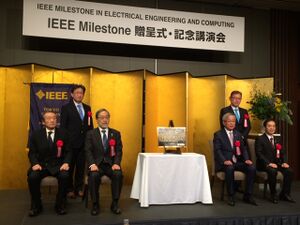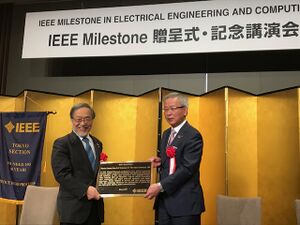Milestones:Fiber Optic Connectors, 1986
Title
Physical Contact Push-Pull Technology for Fiber Optic Connectors, 1986
Citation
In 1986, Nippon Telegraph and Telephone Corp. (NTT) invented the physical contact connection technology that advanced performance and reliability of fiber optic connectors. NTT developed Single-fiber Coupling (SC) and Multifiber Push-On (MPO) connectors; their compactness and simple push-pull operation were major advantages. Widely adopted by carriers and data centers since 1990, this technology facilitated the construction of systems for near light-speed, digital, global communications.
Street address(es) and GPS coordinates of the Milestone Plaque Sites
1-7-1 Hanabatake, Tsukuba-city, Ibaraki 305-0805, Japan, Longitude: 140.089468 Latitude: 36.128387, 1-7-1 Hanabatake, Tsukuba-city, Ibaraki 305-0805, Japan, Longitude: 140.089468 Latitude: 36.128387
Details of the physical location of the plaque
The mounting is predicted in the ground floor entrance hall.
How the plaque site is protected/secured
The plaque will be freely accessible to the public. During the opening hours, staff in charge is always present. A night watchman is provided as well.
Historical significance of the work
A fiber optic connector, which makes it possible to connect/disconnect optical fiber, is an indispensable device when constructing optical fiber network systems. The connector connects optical fibers by butt-jointing ferrules that have a high precision hole in which an optical fiber is fixed in place with adhesive. In the history of the development of the fiber optic connector, the physical contact (PC) connection technology invented by NTT has been fundamental in supporting the performance and reliability of the current commercially available fiber optic connectors. Before the PC connection was invented, refractive index matching material was applied to the fiber endface to suppress the Fresnel reflection induced by the air gap between connected fibers. However, if the connection must be performed repeatedly, it is better to eliminate the need for refractive index matching material. To meet this requirement, NTT invented the PC connection where fiber endfaces are brought into direct contact by pressing ferrules together. The PC connection reduces the reflected light power to about 1/1000 of the signal light power at the connection point and achieves a stable loss of less than 0.5 dB without the need for refractive index matching material. Fiber optic connectors can be divided into two types: simplex and multiplex. NTT used PC connection technology to develop an SC connector and an MPO connector as representative simplex and multiplex connectors. The SC and MPO connectors have a push-pull coupling mechanism that makes it possible to connect/disconnect a plug and an adapter by pushing/pulling the coupling sleeve in the insertion/removal direction. The plug cannot be removed from the adapter simply by pulling the optical fiber. On the other hand, the plug can be easily removed from the adapter by pulling the coupling sleeve. Before the push-pull coupling mechanism was invented, the plug was coupled with the adapter by rotating a coupling nut with the fingers. From the 1980s to the 1990s, a connector was required that could realize a high-density connection at low cost for access network systems. Conventional connectors such as the FC and ST connectors did not satisfy these requirements because they need a large space to allow the coupling nut to be rotated with the fingers. The push-pull coupling mechanism enables us to realize high-density connection with superior operability.
Features that set this work apart from similar achievements
In 1985, NTT completed an optical fiber network over a distance of 2000 km from Hokkaido to Kyushu in Japan. The FC connector developed by NTT in 1979 was used to construct the above-mentioned optical fiber network. In 1985, the ST connector was developed by AT&T. These early connectors required the application of refractive index matching material to the fiber endface to suppress the Fresnel reflection induced by the air gap between the connected fibers. In these connectors, the plug was coupled with the adapter by rotating a coupling nut with the fingers.
In 1986, NTT developed a mechanically transferable (MT) connector for optical fiber cable joints. This was needed to connect two sets of fiber ribbons together in a confined space such as the closure used for access network systems. In the MT connector, the fiber ribbon is inserted into a row of fiber holes between two guide holes and fixed in place with adhesive. The ferrules are aligned by inserting two guide pins into two guide holes. The coupled ferrules are held together with a clamp spring. Refractive index matching material is used between the ferrule endfaces to reduce the Fresnel reflection caused by the air-gap between the connected fibers.
The PC connection enables us to perform the connection repeatedly with excellent optical performance, environmental durability, and operability without the use of refractive index matching material. Most major connectors that have been standardized and are now in practical use employ PC connection technology. The SC connector, which provides the PC connection, has a plastic-molded rectangular housing with a unique push-pull coupling mechanism that makes the connector easy to operate and provides a quad connection density comparable to that of the FC connector. The push-pull mechanism that employs the plastic molded parts helped to reduce the cost of manufacturing the connector. The SC connector share of the worldwide market reached its maximum of 70 % in 1999.
The multifiber push-on (MPO) connector using the PC connection enables us to achieve a high return loss without using refractive index matching material. The MPO connector with a push-pull mechanism also provides ease of operation when connecting or disconnecting multifiber. Only the MPO connector is in widespread use as a standard multifiber PC connector.
Significant references
<Technical papers>
[1] N. Suzuki, M. Saruwatari, and M. Okuyama, “Low insertion- and high return-loss optical connectors with spherically convex-polished end,” Electron. Lett., vol. 22, no. 2, pp. 110-112, 1986.
[2] E. Sugita, K Iwasa, and T. Shintaku, “Design of High-Performance Push-Pull Coupling Optical Fiber Connector” IEICE Trans. Electron.(Japanese Edition), vol. J70-C, no. 10, pp. 1405-1414, 1987.
[3] E. Sugita, R. Nagase, K. Kanayama, and T. Shintaku, “SC-type single-mode optical fiber connectors,” IEEE J. Lightwave Technol., vol. 7, no. 11, pp. 1689-1696, 1989.
[4] S. Nagasawa, Izumi Sankawa, T. Satake, amd N. Kashima, “Small-Size Push-on Type Optical Fiber Connector,” The Transactions of The IEICE, vol. E70, No. 5, pp. 451-454, 1987.
[5] S. Nagasawa, Y. Yokoyama, F. Ashiya, and T. Satake, “A Sigle-mode Multifiber Push-on connector with Low Insertion- and High Return Losses,” ECOC 1991, MoB1-7, pp. 49-52, 1991.
<Patents>
[6] Japan Patent JPA 1987106419, “Fiber optic connector”.
[7] Japan Patent JPA 1987078507, “Optical connector”.
[8] Japan Patent JPA 1992336509, “Multi-fiber optical connector plug”.
[9] Japan Patent JPA 1993034550, “Multi-fiber optical connector”.
<Standards>
[10] IEC 61754-4, Fibre Optic connector interfaces – Part 4: Type SC connector family
[11] IEC 61754-7-1, Fibre Optic connector interfaces - Part 7-1: Type MPO connector family - One fibre row
[12] IEC 61754-7-2, Fibre Optic connector interfaces - Part 7-2: Type MPO connector family - Two fibre rows
[13] IEC 61755-3-1, Fibre Optic connector optical interfaces – Part 3-1: Optical interface, 2,5 mm and 1,25 mm diameter cylindrical full zirconia PC ferrule, single mode fibre
[14] IEC 61755-3-31, Fibre Optic connector optical interfaces – Part 3-31: Optical interface, 8 degrees angled PC, ployphenylene sulphide rectangular ferrule, single mode fibres
[15] IEC 61755-3-32, Fibre Optic connector optical interfaces – Part 3-32: Optical interface, 8 degrees angled PC, thermoset epoxy rectangular ferrule, single mode fibres

